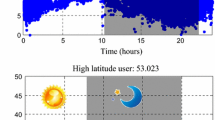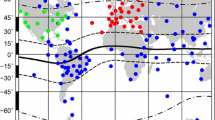Abstract
As an important component of the augmentation service, the ionospheric grid contributes to improving single-frequency positioning accuracy. The ionospheric delay corrections are broadcast as vertical delay estimates at specified ionospheric grid points (IGPs) for most satellite-based augmentation system, where the IGPs are predefined with a resolution of 5° and 5° in latitude and longitude. Different from the general strategy, the COMPASS IGPs are predefined with a resolution of 2.5° and 5° in latitude and longitude. The need for this special IGPs distribution is investigated with experiments using real data. The performance of the COMPASS ionospheric grid is analyzed in terms of accuracy and availability. Comparing the performance of the special IGPs distribution with that of 5° × 5° IGPs, the results show that the ionospheric correction improves by 0.2 m and the 3D positioning accuracy improves by 1 m in middle-low latitude regions. The RMS of the COMPASS grid ionospheric correction accuracy is better than 0.5 m in most regions of the China mainland, and the availability is better than 95 % except in the northeast, northwest and outside China. In addition, we investigated the performance of the method that combined the inverse distance weighted and spherical harmonics grid modeling algorithm. Simulations show that the new method clearly improves grid availability. The mean availability in the mainland is better than 99 %.









Similar content being viewed by others
References
Beutler G, Rothacher M, Schaer S, Springer T, Kouba J, Neilan R (1999) The International GPS Service (IGS): an interdisciplinary service in support of Earth sciences. Adv Space Res 23(4):631–653
Cao Y, Zhou S, Hu X, Wu B, Zhou S, Liu L, Su R, Chang Z, He F, Zhou J (2012) The wide-area difference system for the regional satellite navigation system of COMPASS. Sci China Phys Mech Astron 55(7):1307–1315
Chen J, Wu B, Hu X, Zhou S, Wu X, Xing N (2012) COMPASS/Beidou: system status and initial service; IGS Workshop on GNSS Biases, 18–19 Jan 2012, University of Bern, Switzerland
Conker RS, El-Arini MB, Albertson TW, Klobuchar JA, Doherty PH (1997) Description and assessment of real-time algorithms to estimate the ionospheric error bounds for WAAS. Navigation 44(1):77–87
CSNO (2012) Beidou navigation satellite system signal in space interface control document, open service signal B1I (Version 1.0), China satellite navigation officer December 2012. http://en.beidou.gov.cn/
Fan J, Wu X, Li Y, Wei G (2013a) COMPASS satellites DCB parameter accuracy assessment base on tri-frequency data. Chin Space Sci Technol 33(4):62–70
Fan J, Wu X, Dong E, Zhao H, Kan H, Xie J (2013b) Ionospheric grid modeling of regional satellite navigation system with spherical harmonics. In: Proceedings of China Satellite Navigation Conference (CSNC) 2013, pp 113–122
Han C, Yang Y, Cai Z (2011) BeiDou navigation satellite system and its timescales. Metrologia 48(4):213–218
Hansen A, Peterson E, Walter T, & Enge P (2000). Correlation structure of ionospheric estimation and correction for WAAS. In: Proceedings of ION NTM 2000, Institute of Navigation, Anaheim, CA, January, pp 454–463
Hernandez P, Juan JM, Sanz J, Orus R, Garcia A, Feltens J, Komjathy A, Schaer SC, Krankowski A (2009) The IGS VTEC maps: a reliable source of ionospheric information since 1998. J Geod 83(3):263–275
Huang Z, Yuan H (2008) New algorithm and results of WAAS ionospheric delay correction. Chin J Space Sci 28(2):132–136
Mendillo M, Huang C, Pi X, Rishbeth H, Meier R (2005) The global ionospheric asymmetry in total electron content. J Atmos Solar Terr Phys 67(15):1377–1387
Montenbruck O, Hauschild A, Steigenberger P, Hugentobler U, Teunissen P, Nakamura S (2013) Initial assessment of the COMPASS/Beidou-2 regional navigation satellite system. GPS Solut 17(2):211–222
Prasad N, Sarma AD (2004) Ionospheric time delay estimation using IDW grid model for GAGAN. J Indian Geophys Union 8(4):319–327
Rishbeth H, Müller-Wodarg I, Zou L, Fuller-Rowell T, Millward G, Moffett R, Aylward A (2000) Annual and semiannual variations in the ionospheric F2-layer: II. Physical discussion. Ann Geophys 18(8):945–956
RTCA DO-229D (2006) Minimum operational performance standards for global positioning system/wide area augmentation system airborne equipment
Skone S, Yousuf R, Coster A (2004) Performance evaluation of the wide area augmentation system for ionospheric storm events. J Glob Position Syst 3(1–2):251–258
Wang G, Ji J, Feng L, Wu X (2004) Analysis of EGNOS ionospheric correction. Sci Surv Mapp 29(5):45–49
Wanninger L (1995) Enhancing differential GPS using regional ionospheric error models. Bull Géodésique 69(4):283–291
Wu X, Han C, Ping J (2013a) Monitoring and analysis of regional ionosphere with GEO satellite observations. Acta Geodaetica Cartogr Sin 42(1):13–18
Wu X, Hu X, Wang G, Zhong H, Tang C (2013b) Evaluation of COMPASS ionospheric model in GNSS positioning. Adv Space Res 51(6):959–968
Xing N, Wu X, Hu X, Su R (2012) The analysis of secular change in COMPASS DCB. In: Proceedings China Satellite Navigation Conference (CSNC) 2012, pp 243–251
Yang Y, Li J, Xu J, Tang J, Guo H, He H (2011) Contribution of the COMPASS satellite navigation system to global PNT users. Chin Sci Bull 56(26):2813–2819
Zhou S, Cao Y, Zhou J, Hu X, Tang C, Liu L, Guo R, He F, Chen J, Wu B (2012) Positioning accuracy assessment for the 4GEO/5IGSO/2MEO constellation of COMPASS. Sci China Phys Mech Astron 55(12):2290–2299
Acknowledgments
The authors would like to thank the anonymous reviewers for their thoughtful reviews, and Professor Hu, Professor Chen and Doctor Li for their helpful comments. Thanks the IGS official website for the free data download service. This work was supported by the National Natural Science Foundation of China (41204023, 11203059, 41204022, 41174027), the National High Technology Research and Development Program of China (2013AA122402) and China Satellite Navigation Conference Commission (CSNC2012-QY-7).
Author information
Authors and Affiliations
Corresponding author
Rights and permissions
About this article
Cite this article
Wu, X., Zhou, J., Tang, B. et al. Evaluation of COMPASS ionospheric grid. GPS Solut 18, 639–649 (2014). https://doi.org/10.1007/s10291-014-0394-4
Received:
Accepted:
Published:
Issue Date:
DOI: https://doi.org/10.1007/s10291-014-0394-4




